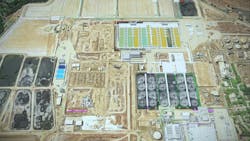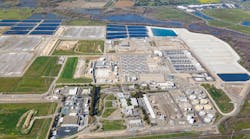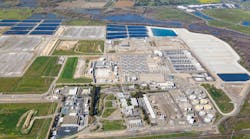EchoWater project advances wastewater treatment to help relieve multiyear drought in Sacramento
A new evolution in wastewater treatment
Owned and operated by Sacramento Regional County Sanitation (Regional San), the Sacramento Regional Wastewater Treatment Plant near Elk Grove, California, treats 135 million gallons of wastewater daily from 1.6 million people throughout Sacramento County and West Sacramento. When new permit discharge requirements were issued back in 2010, Regional San began exploring various strategies to upgrade their existing infrastructure to perform cutting-edge treatment processes that deliver safe and reliable water to be used for recycled purposes, including irrigation for local agriculture. Known as EchoWater, the project evolved into a decade-long facility expansion to improve water quality, alleviate ecological issues, and provide some relief to California’s multiyear, drought-ridden agricultural industry.
The EchoWater upgrade is among the largest public works projects in Sacramento’s history, consisting of 22 individual engineering projects. The Biological Nutrient Removal (BNR) project is at the heart of the new wastewater treatment process, responsible for ammonia and nitrogen removal, while tertiary treatment, filtration, and enhanced disinfection leave the final effluent water clean and reusable. “Our upgraded treatment process now removes 99% of ammonia and 89% of nitrogen from the wastewater,” said Christoph Dobson, general manager at Regional San. Completed in the spring of 2023, the EchoWater project makes the Sacramento facility the second-largest treatment plant of its kind in the United States, providing high-quality recycled water while supporting water sustainability in the region.
Addressing massive upgrade costs and coordination challenges
The EchoWater Project had a budget of USD 2.1 billion, with estimated spending of over USD 1 billion in construction contracts for new treatment facilities. These facilities included over a dozen concrete structures, pumping stations, and electrical installations, which together used 41,350 tons of steel and over 225,000 cubic yards of concrete. Executing these massive, multiple, and often simultaneous projects required over 100,000 construction activities occurring on an active wastewater treatment facility. Therefore, the team needed meticulous organizational, planning, and coordination capabilities.
Project Controls Cubed (PC3) was contracted to manage the planning, scheduling, and cost control. “Planning and managing the design and construction of 22 projects, many occurring simultaneously, on an active wastewater treatment complex was challenging,” said Serelle Corn, managing member at PC3. PC3 needed to find a platform that could accommodate master design and construction management, as well as an operational shutdown model, to meet the demands of the wastewater expansion program and plan for every major shutdown within the 10-year program.
Moreover, EchoWater was being funded by consumers, causing their rates to triple. “One of the top priorities was to control the cost and minimize the impact to the rate payers,” said Jeff Campbell, director of virtual planning at PC3. Keeping costs down was not only essential for Sacramento area customers, but also for funding additional agriculture and habitat reuse initiatives. To maintain control, minimize costs, and streamline coordination among the numerous stakeholders and contractors, PC3 knew that they needed a technology solution to plan and manage the complex construction sequences across multiple projects. They wanted to develop a detailed digital program schedule linked with resource and cost information that could be monitored in real time, tracking and reporting progress and financial status.
Leveraging SYNCHRO for enhanced project visibility
PC3 advocated using Bentley’s SYNCHRO to simulate construction works and ensure safety and efficiency at every project stage. They worked in partnership with the SYNCHRO team to support the growth and success of the project. Combined with iTwin technology, PC3 created a digital twin of the facility that was fully synced with every aspect of the physical site and its multiple components. “The goal was to develop the best digital twin possible to produce optimal and timely situational awareness for the stakeholders,” said Corn. Various users, from designers to contractors, could use the digital twin to prepare for and carry out all the activities that had to be done, working in real time to identify problems in advance. “Just trying to schedule or plan those sequences is in our opinion impossible without the use of a digital twin,” said Campbell.
Through the daily use of SYNCHRO, Bentley’s suite of digital construction solutions, the team was able to anticipate and mitigate potential obstacles and shutdowns, as well as gain timely insight and situational awareness for better project planning, cost control, and schedule performance. The solution was vital to anticipate and mitigate many obstacles. With SYNCHRO, PC3 was able to integrate 3D models in a 4D/5D digital construction and cost analysis environment. The digital twin was crucial to managing the BNR treatment process and the entire EchoWater project, enabling all stakeholders to visualize the design, equipment access, multiproject integration, and traffic during constructability reviews. SYNCHRO’s 5D model facilitated visual schedule variance analysis to better understand construction performance, cost management, and automated schedule activities. It allowed the team to meet stringent concrete pour demands and help optimize operations during planned shutdowns.
Digital twin realizes savings to support environmental stewardship and sustainability
The enhanced situational and logistics awareness provided by SYNCHRO’s digital twin created actionable intelligence that reduced cost and risk early in the design phase. PC3 created new specifications, which required the contractor to submit a 5D SYNCHRO project with their baseline schedule and with each month’s progress update. Compared to previous projects, the quality and timing of the baseline schedule review and acceptance vastly improved, taking weeks instead of months. The digital twin streamlined contractor and stakeholder coordination and optimized construction sequencing, reducing overall program costs by $400 million. “The fact that Regional San recommended that we require the contractor to use SYNCHRO on the tertiary treatment facility was a game changer for the industry,” said Campbell. “Not only did the contractor adopt the technology, but SYNCHRO also became their primary application for planning and managing the construction. It was an overwhelming success and really proved to everyone the power of Bentley’s digital construction platform.”
The entire EchoWater project was successfully delivered on schedule and under budget. “We were able to use Bentley’s digital construction solutions to meet all regulatory compliance requirements. The SYNCHRO project was shown in weekly meetings where the construction manager, project management office, and contractor would review and solve problems together, mitigating risks in the field. The original estimate projected costs to be as much as $2.1 billion, and the final cost is about $1.7 billion, drastically reducing the impact to customers’ rates,” said Corn. Aligned with Regional San’s commitment to environmental stewardship and sustainability, the project cost savings are being used to fund their Harvest Water program, providing recycled clean water to the agricultural lands and existing habitats in southern Sacramento County. As one of the largest agricultural reuse projects in the United States, the recycled water initiative will irrigate up to 16,000 acres of land used for agriculture or habitat conservation. “We are giving farmers more sustainability because they have this [new] reliable water source, but at the same time we are getting a lot of environmental benefits,” said Dobson.
Project summary
Organization: Project Control Cubed LLC
Solution: Water and Wastewater
Location: Sacramento, California, United States
Project objectives:
- To upgrade wastewater treatment for safe discharge into the Sacramento River and recycled water purposes.
- To generate a digital twin for visual situational awareness, construction sequencing, and cost control.
Project Playbook: iTwin, LumenRT, OpenRoads, SYNCHRO
Fast facts
- Regional San initiated the decade-long EchoWater facility upgrade to provide safe and reliable treated water for recycled water use.
- PC3 leveraged SYNCHRO and iTwin to develop a digital twin to manage 22 engineering projects on an active wastewater treatment plant.
- SYNCHRO’s 5D digital twin facilitated timely situational awareness of cost and schedule performance.
ROI
- The new treatment process remove 99% of ammonia and 89% of nitrogen.
- EchoWater was completed USD 400 million under budget, saving taxpayers more than half a billion dollars.
About the Author
Neda Simeonova
Neda Simeonova is a senior product marketing manager, Water Infrastructure, at Bentley Systems. Neda has been involved in the water, wastewater, and stormwater infrastructure industry for over 18 years, including as the former editorial director of Water & Wastes Digest, Storm Water Solutions and Water Quality Products magazines where she focused on industry trends, technology advancements, and water policies.


